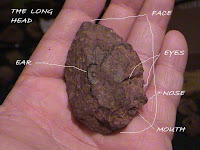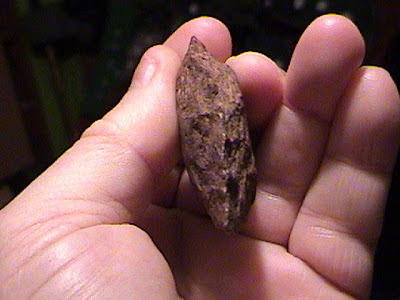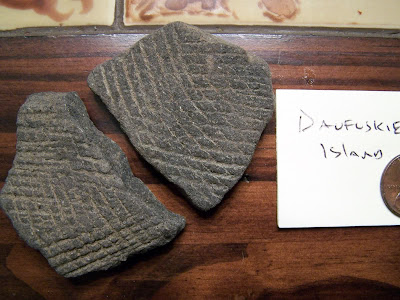Daufuskie Island, South Carolina, portable carvings are in typical Paleolithic rock art patterns which have been thought to originate in altered mind states, reflecting visual patterns generated and interpreted in the brain's visual cortex (click photos to expand)
Amateur archaeologist's likely
entoptic finds, South Carolina, 3 engraved plaquettes
Rebecca Partridge writes of these kinds of patterns: "Entopic (sic) Phenomena and The Origins of Art
I begin my discussion of abstraction and mysticism at the beginning, with the first appearance of abstract forms. These appeared in cave paintings largely situated around Western Europe created during the upper Palaeolithic between 45,000 and 20,000 years ago. The period between the middle and upper Palaeolithic has been called The Transition, as humans relatively quickly developed distinctive cultures involving ritual and the creation of art. There are no concrete explanations as to the motivations and meanings of Palaeolithic art, however it is generally agreed amongst archaeologists that the evidence point to creation during altered states of consciousness. These states occur through various means, hallucinogenic drugs, sensory deprivation, mind control techniques such as repetitive sound or movement, through dreams, psychological and physical illnesses. These early artists may have ingested drugs or it could have been a sensory reaction to the darkness in the cave, either way the forms that they painted have since been found to be common to many altered states. In his book, The Mind in the Cave’,
David Lewis Williams outlines three stages of visual hallucinations, which he applies to the production of cave painting;
‘ In the first and ‘lightest’ stage people may experience geometric precepts that include dots, grids, zig zags, nested coronary curves, and meandering lines. Because these precepts are ‘wired’ into the human nervous system, all people, no matter what their cultural background, have the potential to experience them.
The first stage may include forms which fall into the following categories, grid patterns; lattices, honeycombs, chessboards, and circular forms; cobwebs, tunnels and funnels. These patterns appear in vivid colours, expanding contracting and overlaying, often there is a bright light in the centre of the visual field. He identifies these forms as ‘entopic (sic) phenomena’ images produced both within the eye and in the visual cortex. These images are in the ‘minds eye’, seen with the eyes closed or open projected onto the surrounding space."
Please see this earlier posting about a
grid I discovered in Seneca Caverns in Ohio, pictured just below. There is an underground river in this cave and it may have been a location where altered mind states were pursued. The absolute darkness of the cave may have assisted with this. There is a very strong similarity between the Seneca Cavern, Ohio, grids and aspects of the Daufuskie Island, South Carolina grids. I suggest they were made in the same tradition.
Seneca Cavern, Ohio
Daufuskie Island, South Carolina
-kbj



.jpg)












+cropped+2.jpg)
.jpg)
.jpg)
+cropped.jpg)
+cropped.jpg)
+cropped.jpg)
.jpg)
Combarelles-mammouth.jpg)












+cropped.jpg)
.jpg)
.jpg)
.jpg)










.jpg)



+cropped.jpg)

.jpg)

